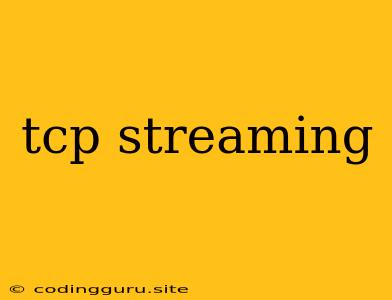TCP Streaming: A Comprehensive Guide
TCP streaming is a fundamental concept in computer networking, enabling the reliable and ordered transmission of data over the internet. This guide will delve into the intricacies of TCP streaming, explaining its working principles, advantages, and applications.
What is TCP Streaming?
TCP, or Transmission Control Protocol, is a foundational protocol in the internet's communication infrastructure. It operates at the transport layer of the TCP/IP model, providing a reliable and ordered mechanism for data transfer between two networked devices.
TCP streaming leverages this reliability by establishing a persistent connection between the sender and receiver. This connection ensures that data packets are delivered in the correct sequence, with mechanisms for error detection and retransmission. Unlike UDP (User Datagram Protocol), which is a connectionless protocol and offers minimal guarantees, TCP streaming ensures data integrity and provides a consistent flow of information.
How Does TCP Streaming Work?
The core of TCP streaming lies in its connection-oriented approach. Here's how it works:
-
Three-Way Handshake: Before data transmission commences, a three-way handshake process is initiated. The sender sends a SYN (synchronization) packet to the receiver, initiating the connection request. The receiver responds with a SYN-ACK (synchronization-acknowledgement) packet, confirming its willingness to establish the connection. Finally, the sender acknowledges the receiver's response with an ACK (acknowledgement) packet, completing the handshake and establishing the connection.
-
Data Segmentation: Once the connection is established, data is segmented into smaller packets. Each packet includes a sequence number, allowing the receiver to identify the correct order of the received data.
-
Error Detection and Retransmission: TCP uses checksums to detect corrupted packets during transmission. If a packet is lost or corrupted, the receiver sends an ACK indicating the missing packet. The sender then retransmits the lost packet, ensuring data integrity.
-
Flow Control: To prevent the receiver from being overwhelmed with data, TCP employs flow control mechanisms. The receiver sends acknowledgments indicating its current buffer capacity, allowing the sender to adjust its transmission rate accordingly.
Advantages of TCP Streaming
TCP streaming offers numerous advantages over connectionless protocols:
- Reliability: TCP ensures data delivery with error detection and retransmission mechanisms.
- Order: Data is received in the order it was sent, crucial for applications requiring consistent data flow.
- Flow Control: Prevents receiver overload and ensures efficient data transmission.
- Congestion Control: TCP adapts to network congestion, optimizing transmission efficiency.
- Security: TCP offers basic security features like checksums, which help in detecting malicious alterations.
Applications of TCP Streaming
TCP streaming is ubiquitous, powering numerous applications:
- Web Browsing: HTTP (Hypertext Transfer Protocol) uses TCP to download web pages and associated resources.
- File Transfer: FTP (File Transfer Protocol) and SFTP (Secure File Transfer Protocol) rely on TCP for secure and reliable file transfer.
- Email: SMTP (Simple Mail Transfer Protocol) uses TCP to transmit email messages.
- Streaming Services: Services like Netflix, YouTube, and Spotify use TCP to stream video and audio content.
- Video Conferencing: Platforms like Zoom and Google Meet utilize TCP for reliable and consistent video conferencing.
- Online Gaming: Multiplayer games often leverage TCP for real-time communication and data synchronization.
Choosing TCP Streaming:
While TCP streaming offers significant advantages, it's crucial to consider its limitations:
- Overhead: The connection establishment overhead can add latency, making it less suitable for real-time applications with stringent latency requirements.
- Complexity: The error detection and retransmission mechanisms can increase network traffic.
- Resource Consumption: TCP connections consume system resources, potentially impacting performance.
Alternatives to TCP Streaming
In scenarios demanding low latency or minimal overhead, alternative protocols like UDP (User Datagram Protocol) can be considered. However, UDP provides no guarantees for data delivery or order, making it unsuitable for applications requiring reliability and data integrity.
Conclusion
TCP streaming is a cornerstone of internet communication, providing a reliable and ordered mechanism for data transfer. Its features make it ideal for numerous applications, but its overhead and resource consumption should be carefully considered. Understanding the nuances of TCP streaming is essential for building robust and reliable network applications.
